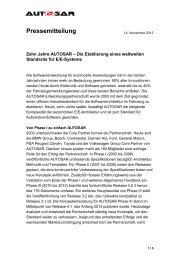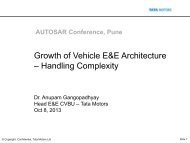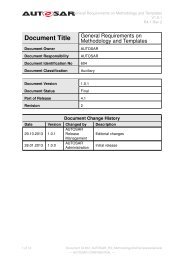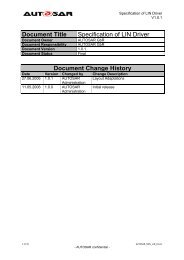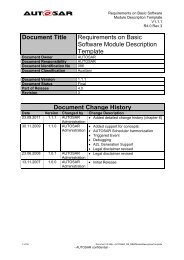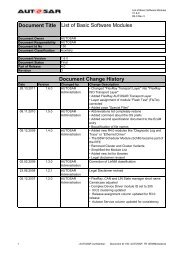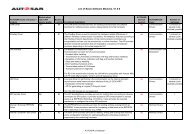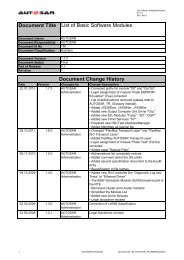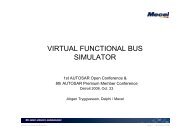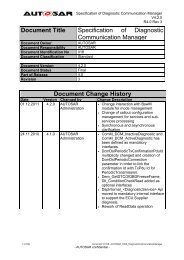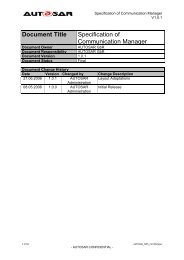A worldwide standard Current developments, roll-out and ... - autosar
A worldwide standard Current developments, roll-out and ... - autosar
A worldwide standard Current developments, roll-out and ... - autosar
You also want an ePaper? Increase the reach of your titles
YUMPU automatically turns print PDFs into web optimized ePapers that Google loves.
AUTOSAR - A <strong>worldwide</strong> <strong>st<strong>and</strong>ard</strong><br />
<strong>Current</strong> <strong>developments</strong>, <strong>roll</strong>-<strong>out</strong> <strong>and</strong> <strong>out</strong>look<br />
Frank Kirschke-Biller, Ford Motor Company<br />
Co-Authors:<br />
Simon Fürst, BMW Group<br />
Steffen Lupp, Bosch<br />
Stefan Bunzel, Continental<br />
Stefan Schmerler, Daimler<br />
Robert Rimkus, General Motors<br />
Alain Gilberg, PSA Peugeot Citroën<br />
Kenji Nishikawa, Toyota Motor Corporation<br />
Andreas Titze, Volkswagen<br />
1. Abstract/Summary<br />
The AUTomotive Open System ARchitecture (AUTOSAR) was founded as a development<br />
partnership in 2003. Surveys show that it is today the global automotive software <strong>st<strong>and</strong>ard</strong>.<br />
<strong>Current</strong>ly AUTOSAR is in the middle of its third development phase (2010-2012).<br />
This document will give a short overview of the most important results of Phase II (2007-<br />
2009), which were made available by releases 3.0/3.1 <strong>and</strong> 4.0. The focus of release 3.x was<br />
on internal harmonization of the basic software modules <strong>and</strong> templates, whereas release 4.0<br />
introduced important new technologies such as support for functional safety <strong>and</strong> multi-core<br />
architectures.<br />
Exploitation plans show that releases 3.x are today widely used in series production <strong>and</strong> will<br />
be in the future. Release 4.0 however will gain importance rapidly <strong>and</strong> is currently getting<br />
introduced in series development.<br />
An update on achievements of Phase III <strong>and</strong> the future release plans will be presented.
1. Introduction<br />
1.1. Technical Background<br />
The objective of AUTOSAR is to establish an open global industry <strong>st<strong>and</strong>ard</strong> for the automo-<br />
tive software architecture between suppliers <strong>and</strong> manufacturers [2]. The <strong>st<strong>and</strong>ard</strong> comprises<br />
a set of specifications describing software architecture components <strong>and</strong> defining their inter-<br />
faces [3]. The principal aim of the <strong>st<strong>and</strong>ard</strong> is to master the growing complexity of automotive<br />
electronic <strong>and</strong> software architectures. The need to build a common architecture as well as<br />
development methodology <strong>and</strong> application interfaces became stringent for a variety of rea-<br />
sons, among which:<br />
� Defining a common underst<strong>and</strong>ing how electronic control units (ECU) cooperate on<br />
same functions.<br />
� Separating the software from the hardware in order to allow software reuse <strong>and</strong><br />
smooth evolutions limiting re-development <strong>and</strong> validation.<br />
� Finally AUTOSAR is enabling multiple different functions as for example software<br />
modules to be hosted on the same ECU, independently from the supplier of either<br />
part.<br />
The ongoing development of AUTOSAR based products by the member companies provides<br />
a unique feedback loop into the development of the <strong>st<strong>and</strong>ard</strong> itself. This allows fast <strong>and</strong><br />
pragmatic improvements <strong>and</strong> adaptations to market needs. The reusability of software has<br />
already been experienced in major <strong>developments</strong> <strong>and</strong> it has resulted in substantial savings in<br />
the overall development costs.<br />
AUTOSAR<br />
Software<br />
Component<br />
Interface<br />
St<strong>and</strong>ard<br />
Software<br />
Interfaces:<br />
VFB & RTE<br />
relevant<br />
RTE<br />
relevant<br />
BSW<br />
relevant<br />
Possible interfaces<br />
inside<br />
Basic Software<br />
(which are<br />
not specified<br />
within AUTOSAR)<br />
Application<br />
Software<br />
Component<br />
AUTOSAR<br />
Interface<br />
St<strong>and</strong>ardized<br />
Interface<br />
Operating<br />
System<br />
St<strong>and</strong>ardized<br />
Interface<br />
Actuator<br />
Software<br />
Component<br />
AUTOSAR<br />
Interface<br />
Sensor<br />
Software<br />
Component<br />
AUTOSAR<br />
Interface<br />
AUTOSAR Runtime Environment (RTE)<br />
St<strong>and</strong>ardized<br />
AUTOSAR<br />
Interface<br />
Services<br />
St<strong>and</strong>ardized<br />
Interface<br />
St<strong>and</strong>ardized<br />
Interface<br />
Communication<br />
St<strong>and</strong>ardized<br />
Interface<br />
Basic Software<br />
ECU-Hardware<br />
AUTOSAR<br />
Software<br />
..............<br />
AUTOSAR<br />
Interface<br />
ECU<br />
Abstraction<br />
St<strong>and</strong>ardized<br />
Interface<br />
St<strong>and</strong>ardized<br />
Interface<br />
Microcont<strong>roll</strong>er<br />
Abstraction<br />
Figure 1: AUTOSAR Software Architecture – Components <strong>and</strong> Interfaces<br />
Application<br />
Software<br />
Component<br />
AUTOSAR<br />
Interface<br />
AUTOSAR<br />
Interface<br />
Complex<br />
Drivers
AUTOSAR has become the global automotive SW <strong>st<strong>and</strong>ard</strong> with regards to technology lead-<br />
ership <strong>and</strong> overall industry participation. Analysis of sales data show that more than 80% of<br />
the global automotive production volume is made by OEMs which are AUTOSAR members.<br />
Cars produced by non-members<br />
~ 19%<br />
Figure 2: Volume of cars sold in 2009<br />
1.2. Project Organization<br />
2009 Sold Cars<br />
(Total Volume: ~ 60 Mio)<br />
~ 81%<br />
Cars produced by AUTOSAR members<br />
Since its foundation in 2003, the AUTOSAR Development Partnership has provided several<br />
releases as a result of its joint development activities. The work of the AUTOSAR Partner-<br />
ship can be divided into the following periods:<br />
� Phase I (2004-2006): Basic development of the <strong>st<strong>and</strong>ard</strong> (Release 2.1 at the end of<br />
Phase I in 2006, AUTOSAR finalized the first set of major specifications).<br />
� Phase II (2007-2009): Extension of the <strong>st<strong>and</strong>ard</strong> in terms of architecture <strong>and</strong> method-<br />
ology to serve market needs <strong>and</strong> increase robustness (Release 3.0/3.1 <strong>and</strong> release<br />
4.0).<br />
� Phase III (2010-2012): Maintenance <strong>and</strong> improved maintainability of the different re-<br />
leases used for series production <strong>and</strong> support of the exploitation into the market.
Phase I Phase II Phase III<br />
Development of the architecture <strong>and</strong> methodology<br />
R 1.0 R 2.0/2.1 R 3.0/3.1<br />
Release 4.0<br />
Selective enhancement<br />
Release 4.0<br />
Rel. 3.2<br />
Maintenance <strong>and</strong> support of the exploitation<br />
Release 2.1/3.0/3.1<br />
Release 4.0<br />
Release 3.2<br />
2004 2005 2006 2007 2008 2009 2010 2011 2012<br />
Figure 3: AUTOSAR Timeline<br />
<strong>Current</strong>ly AUTOSAR is in the middle of its third phase (2010-2012).<br />
2. <strong>Current</strong> Releases of AUTOSAR<br />
2.1. A Brief Reflection on AUTOSAR Phase II<br />
The main focus of phase II was extension to market needs of the advanced architecture <strong>and</strong><br />
methodology <strong>st<strong>and</strong>ard</strong>. As a result, releases 3.0 <strong>and</strong> 3.1 closed the remaining gaps in the<br />
basic software <strong>and</strong> harmonized the basic software modules <strong>and</strong> templates. The releases<br />
helped to mature the <strong>st<strong>and</strong>ard</strong>. Basic software (BSW) implementations are available <strong>and</strong> are<br />
actively used in various series projects within the industry. Tool suppliers support the ex-<br />
change formats <strong>and</strong> templates specified by these releases. The interoperability of the tools,<br />
provided by the <strong>st<strong>and</strong>ard</strong>ized exchange format, results in a more powerful tool chain that<br />
enables a true systems engineering approach. Overall the acceptance of the 3.x releases is<br />
high.<br />
The AUTOSAR presentation in Baden-Baden in 2009 [4] announced the upcoming release<br />
4.0 <strong>and</strong> its new technical content. It has been released on time end of 2009.<br />
Release 4.0 introduced important new concepts which are all driven by further developing<br />
market needs to enable state-of-the-art automotive applications. These include most notably:
� Support for functional safety<br />
(e.g. memory partitioning, program flow control, end-to-end library)<br />
� Multi-core support<br />
� Application / vehicle mode management<br />
� Variant h<strong>and</strong>ling<br />
� Timing model<br />
� St<strong>and</strong>ardized application interfaces<br />
Comprehensive solutions for functional safety <strong>and</strong> multi-core technology are an integral part<br />
of the AUTOSAR <strong>st<strong>and</strong>ard</strong>. They address technical challenges which are not covered by any<br />
other <strong>st<strong>and</strong>ard</strong> in the automotive software domain <strong>worldwide</strong> <strong>and</strong> in this way strengthen the<br />
importance of the <strong>st<strong>and</strong>ard</strong>.<br />
Functional Safety<br />
Functional safety is one of the main objectives of AUTOSAR [5]. The <strong>st<strong>and</strong>ard</strong> will support<br />
safety related applications <strong>and</strong> therefore has to consider the upcoming ISO 26262 <strong>st<strong>and</strong>ard</strong><br />
(which will be published in Oct. 2011). Exemplarily the end-to-end communication protection<br />
library (E2E library) is illustrated below as one of the AUTOSAR features, which support<br />
functional safety.<br />
The E2E library implements a state-of-the-art safety protocol at application level. By using<br />
protection mechanisms provided by the library, potential faults in a communication link can<br />
be detected <strong>and</strong> h<strong>and</strong>led at runtime. The provided mechanisms for E2E protection are ade-<br />
quate for safety-related communication having requirements up to ASIL D. The E2E protec-<br />
tion offers the following features:<br />
� It protects the safety-related data elements to be sent over the runtime environment<br />
(RTE) by attaching control data (e.g. data id, sequence counter, checksum).<br />
� It verifies the safety-related data elements received from the RTE using this control<br />
data.<br />
� It indicates that received safety-related data elements are faulty, which then has to be<br />
h<strong>and</strong>led by the receiver SW-C.
E2E<br />
Protection<br />
Library<br />
Application<br />
Sender<br />
SW<br />
Component<br />
S1<br />
AUTOSAR Runtime Environment (RTE)<br />
S2<br />
H1<br />
E2E<br />
protection<br />
wrapper<br />
Microcont<strong>roll</strong>er 1 / ECU 1<br />
Basic Software .<br />
H2<br />
E2E<br />
Protection<br />
Library<br />
Typical sources of interferences, causing errors detected by E2E protection:<br />
Application<br />
S1<br />
Receiver<br />
SW<br />
Component<br />
E2E<br />
protection<br />
wrapper<br />
AUTOSAR Runtime Environment (RTE)<br />
S2<br />
Microcont<strong>roll</strong>er 2 / ECU 2<br />
SW-related sources:<br />
� S1 - Error in the runtime environment (which is mostly generated by tools)<br />
� S2 - Error in network stack<br />
HW-related sources:<br />
� H1 - Failure of HW network, electromagnetic influence (EMI)<br />
� H2 - Microcont<strong>roll</strong>er failure during context switch or on the communication between cores<br />
Figure 4: End-to-end communication protection library<br />
Multi-core Support<br />
Basic Software .<br />
Communication link<br />
(e.g. CAN)<br />
Latest embedded multi-core micro cont<strong>roll</strong>ers provide superior computing power at reduced<br />
power consumption. This increase in computing power is necessary in order to meet the<br />
needs of future control software <strong>and</strong> further integration of functionality. However multiple<br />
cores’ computing power can only be taken advantage of, if the software is designed accord-<br />
ingly. In release 4.0 of the AUTOSAR specification the runtime environment (RTE) <strong>and</strong><br />
AUTOSAR-based OSEK operating system (OS) is extended by multi-core specific functions.<br />
The RTE hides the multi-core details from the application, so the application software can be<br />
developed independent of multi-core issues in a reusable fashion.
Figure 5: Multi-core architecture<br />
Operating<br />
System<br />
(Core 0)<br />
IOC *)<br />
Operating<br />
System<br />
(Core 1)<br />
*) Inter OS-Application communicator<br />
The distribution of application software among cores is supported by the AUTOSAR method-<br />
ology <strong>and</strong> hence by the tool chain. Adding further flexibility w.r.t. load balancing <strong>and</strong> basic<br />
software distribution is planned for the future.<br />
3. AUTOSAR Phase III<br />
With phase III, beginning in 2010, the AUTOSAR Development Partnership continued the<br />
project with a stable register of members.<br />
Main objectives of Phase III are:<br />
� Maintenance of existing releases<br />
� Selective enhancement of the <strong>st<strong>and</strong>ard</strong> driven by market needs<br />
� Improve maintainability of the <strong>st<strong>and</strong>ard</strong><br />
With revision 2 release 4.0 has reached a stable <strong>and</strong> mature stage, which covers important<br />
technologies requested by the market. Revision 2 is the base for first series implementations.
Feedback from these implementations, however, show, that revisions 3 <strong>and</strong> 4 are required to<br />
further optimize release 4.0 <strong>and</strong> to make it applicable with<strong>out</strong> OEM specific extensions.<br />
In order to get a better underst<strong>and</strong>ing ab<strong>out</strong> the current <strong>and</strong> planned usage of available<br />
AUTOSAR releases, feedback from series projects <strong>and</strong> the intended business model for the<br />
respective parts of the AUTOSAR <strong>st<strong>and</strong>ard</strong> a comprehensive survey among the Core Part-<br />
ners was conducted. The results have been used to adopt the release timing <strong>and</strong> technical<br />
content of phase III.<br />
3.1. AUTOSAR Core Partner Exploitation Plans<br />
In this Core Partner survey, different aspects of their AUTOSAR exploitation plans, like<br />
� Preferred migration strategy<br />
� Releases being used / planned to be used in series projects<br />
� Preferred license model for BSW/RTE<br />
� Usage of application interfaces<br />
� Projected volumes of ECUs with AUTOSAR<br />
have been collected <strong>and</strong> analyzed.<br />
Figure 6: Core Partner exploitation plans in platforms (vehicle or ECU platforms)<br />
All Core Partners are using AUTOSAR or are planning to m<strong>and</strong>ate AUTOSAR in future plat-<br />
forms.<br />
One key result is the predicted rapid growth of AUTOSAR’s market penetration between now<br />
<strong>and</strong> 2016. Figure 7 indicates the increasing number of automotive ECUs with AUTOSAR<br />
technology.
Further important key findings from the survey are:<br />
� The main stream of AUTOSAR releases are R3.x <strong>and</strong> 4.0.<br />
� Different migration strategies <strong>and</strong> license models for the BSW <strong>and</strong> the RTE co-exist<br />
<strong>and</strong> will continue to co-exist, even within an OEM.<br />
� Core Partner Tier1s prefer own development of AUTOSAR BSW, instead of purchas-<br />
ing it from Tier2s.<br />
� The majority of the Core Partners will finish their migration to fully compliant<br />
AUTOSAR BSW in 2015.<br />
Figure 7: Volume of ECUs with AUTOSAR inside<br />
(accumulated figures from BMW, Daimler, Ford, GM, PSA, Toyota <strong>and</strong> Volkswagen)<br />
The detailed results of the survey have been shared at the 3 rd AUTOSAR open conference<br />
<strong>and</strong> are published at [6].<br />
3.2. Maintenance of Releases<br />
Implementations based on releases 3.x are already widely used in series projects. The ex-<br />
ploitation survey shows the high acceptance <strong>and</strong> importance of these releases.<br />
To protect the investments in these releases (e.g. in tooling <strong>and</strong> software implementations)<br />
AUTOSAR members require further maintenance <strong>and</strong> improvements of R3.x. The feedback
from the series projects is valuable input for the improvement process. However, at the same<br />
time there is an obvious need for selective enhancements - such as specific R4.0 features -<br />
<strong>and</strong> support of new technologies in these release 3.x-based projects. One of the main drivers<br />
for the introduction of a release 3.2 was the strong <strong>and</strong> short term market need for partial<br />
networking.<br />
Additional new features in release 3.2 are<br />
� Robustness features (especially in state manager modules)<br />
� Improvement of error h<strong>and</strong>ling (e.g. production vs. development errors)<br />
In addition the following features were back-ported from Rel. 4.0<br />
� End-to-end communication protection<br />
� Extended Complex Device Driver (CDD) concept<br />
� Basic Software Mode Manager<br />
� FlexRay ISO Transport Protocol<br />
Partial Networking<br />
By incorporating Partial Networking into the <strong>st<strong>and</strong>ard</strong> (release 3.2.1 as well as 4.0.3),<br />
AUTOSAR addresses the important need for an efficient energy management. The objective<br />
is to reduce power consumption of the overall electrical system by reducing the number of<br />
active ECUs on the bus during vehicle operation. Requirements for the basic software stack<br />
have been identified to enable AUTOSAR to realize a shut down <strong>and</strong> startup of the bus<br />
communication interfaces of groups of ECUs (Partial Network Cluster) during normal bus<br />
communication.<br />
The power consumption can be reduced by e.g.<br />
Shutting down of seat control functions<br />
It shall be possible to shut down nodes responsible for seat control functions during<br />
driving. By default these nodes are in a sleep state. Only when the driver pushes the<br />
seat control switch, those nodes (“seat control” Partial Network) required for seat con-<br />
trol functions are woken up. The “seat control” Partial Network is shut down if none of<br />
the nodes requires bus communication.<br />
Shutting down of park assistant functions<br />
It shall be possible to shut down nodes responsible for park assistant functions de-<br />
pending on the vehicle speed. At a vehicle speed higher than e.g. 30 km/h the nodes
(“park assistant” Partial Network) required for park assistant functions are shut down.<br />
At a lower speed, only those nodes that belong to this Partial Network are woken up.<br />
AUTOSAR is the first initiative to <strong>st<strong>and</strong>ard</strong>ize the Partial Networking technology.<br />
Release 3.2 is in general backward compatible to releases 3.1/3.0. Where needed detailed<br />
Backward Compatibility statements are available in order to ease the transition from release<br />
3.1 to release 3.2 or to assess interoperability.<br />
The fact that there are two main release streams – 3.x <strong>and</strong> 4.0 – within AUTOSAR <strong>and</strong> their<br />
increasing usage in series projects requires a strict control of the backward compatibility<br />
(BWC).<br />
For this purpose Phase III introduces process enhancements to impede incompatible devel-<br />
opments in the <strong>st<strong>and</strong>ard</strong>. The AUTOSAR Backward Compatibility Statement will support<br />
AUTOSAR users in the migration analysis between releases or revisions. The scope is bus<br />
<strong>and</strong> application level, including templates.<br />
3.3. Evolutionary Release Approach<br />
Based on the exploitation plan feedback <strong>and</strong> the wide acceptance of release 3.2 <strong>and</strong> release<br />
4.0 the AUTOSAR Core Partners decided not to introduce another major or minor release<br />
(4.1 or 5.0) during Phase III, but instead to stepwise introduce new content with a clear focus<br />
on backward compatibility. This will further strengthen the stability of AUTOSAR <strong>and</strong> stabilize<br />
the overall AUTOSAR ecosystem. Selected backward compatible concepts will be introduced<br />
in release 4.0.4 by the end of 2012.<br />
4. AUTOSAR Test St<strong>and</strong>ardization<br />
4.1. AUTOSAR Conformance Testing<br />
With release 4.0.2 Conformance Test (CT) specifications for 43 Basic SW modules are<br />
available. These CT specifications are partially specified in TTCN-3 1 for automated test exe-<br />
cution in a test suite <strong>and</strong> partially in check lists that can be automated by the user if required<br />
later on. Undoubtedly, the creation of the AUTOSAR conformance test specification has<br />
helped to improve the quality of each of the BSW module specifications <strong>and</strong> the overall<br />
<strong>st<strong>and</strong>ard</strong>. However it has turned <strong>out</strong>, that neither the fine granularity of the tested modules<br />
1 TTCN-3: Testing <strong>and</strong> Test Control Notation
nor the strict test processes on such a detailed level do exactly fit the business needs of the<br />
AUTOSAR users. Experience shows, that the AUTOSAR BSW is usually not purchased<br />
module-wise, but as a whole. AUTOSAR has therefore decided to create a leaner, more effi-<br />
cient way of testing, which is named Acceptance Testing.<br />
4.2. AUTOSAR Acceptance Testing<br />
The details of the future AUTOSAR acceptance test are currently worked <strong>out</strong>. So far the<br />
scope <strong>and</strong> the main objectives have been agreed. The acceptance test shall enable the<br />
OEM’s <strong>and</strong>/or integrator’s acceptance of a supplier’s platform at bus <strong>and</strong> application level<br />
(ICC1)<br />
Acceptance Acceptance Acceptance Tests Tests Tests<br />
Tests Tests at at Application Level<br />
RTE <strong>and</strong> services<br />
AUTOSAR Runtime Environment<br />
ICC1, ICC2, or ICC3 implementation<br />
Tests Tests at at Bus Bus Level<br />
Figure 8: Volume of ECUs with AUTOSAR inside<br />
This includes tests for<br />
� Bus compatibility (e.g. compatibility of protocols such as TP, NM)<br />
� Application compatibility (Compatibility of interfaces to ensure integration of SWCs)<br />
� Configuration compatibility (Compatibility of templates to ensure that a “typical” ECU<br />
extract can be used for configuration)<br />
5. AUTOSAR’s co-operation with other organizations<br />
AUTOSAR as an international <strong>st<strong>and</strong>ard</strong> will further extend co-operation with other interna-<br />
tional organizations. It will continue its close co-operation with the Japanese Jaspar automo-<br />
tive <strong>st<strong>and</strong>ard</strong>ization consortium<br />
� Common high level meetings are taking place twice a year.<br />
� Exchange between Jaspar <strong>and</strong> AUTOSAR experts on WP level.<br />
� Integration of several Jaspar results into release 4.0.4 is ongoing.
� The AUTOSAR conference in May 2010 took place in Tokyo with strong support by<br />
Jaspar.<br />
A focus will also be on the emerging markets India <strong>and</strong> China, which show a high interest in<br />
AUTOSAR as the international automotive software <strong>st<strong>and</strong>ard</strong>. Exchanges on technical col-<br />
laborations with the Chinese Automotive Electronics St<strong>and</strong>ardization Committee (AESC) <strong>and</strong><br />
Indian organizations are currently ongoing. With the support of a Core Partner, local<br />
AUTOSAR representatives have been established in India <strong>and</strong> China. These additional re-<br />
gional <strong>st<strong>and</strong>ard</strong>ization bodies are not seen as an overlap with AUTOSAR but are rather<br />
complimentary. For example, AUTOSAR does not produce implementations so regional or-<br />
ganizations can collaborate to create a <strong>st<strong>and</strong>ard</strong> implementation. Additionally, regional<br />
<strong>st<strong>and</strong>ard</strong>izations may bring a unique perspective of their respective market <strong>and</strong> drive those<br />
change requests into the AUTOSAR <strong>st<strong>and</strong>ard</strong> (i.e. ECUs to support low content vehicles in<br />
emerging markets).<br />
6. Conclusion<br />
AUTOSAR has become the global <strong>st<strong>and</strong>ard</strong> for embedded automotive software, providing<br />
specifications for<br />
� Software architecture<br />
� Software development methodology<br />
� St<strong>and</strong>ardized application interfaces<br />
Exploitation plans show that the main stream of AUTOSAR releases are releases 3.x <strong>and</strong><br />
releases 4.0. AUTOSAR will help to protect the investments in releases 3.x by maintaining<br />
the release 3.2<br />
The achievements of Phase III so far can be summarized as<br />
� A new minor release 3.2 was introduced addressing the strong market need to enable<br />
partial networking.<br />
� Only backward compatible concepts will be introduced in revision of release 4.0 in-<br />
stead of introducing a new minor or even major release by end 2012. This stepwise<br />
introduction of concepts will strengthen the stability of AUTOSAR <strong>and</strong> stabilize the<br />
overall AUTOSAR ecosystem.<br />
� AUTOSAR Application Interfaces are ready for use <strong>and</strong> <strong>st<strong>and</strong>ard</strong>ization continues.<br />
� Backward Compatibility requirement of Phase III brought to practice.
� Acceptance Tests will fulfill the market dem<strong>and</strong>s much better than Conformance<br />
Tests.<br />
7. References<br />
[1] Official website of the AUTOSAR Partnership: www.<strong>autosar</strong>.org<br />
[2] Heinecke, Harald et al.: AUTOSAR – <strong>Current</strong> results <strong>and</strong> preparations for exploitation,<br />
Euroforum conference May 3 rd 2006<br />
[3] Fennel, Helmut et al.: Achievements <strong>and</strong> Exploitation of the AUTOSAR Development<br />
Partnership, SAE Convergence Congress, 2006, Detroit<br />
[4] Fürst, Simon et al.: AUTOSAR - A Worldwide St<strong>and</strong>ard is on the road, 14 th International<br />
VDI Congress Electronic Systems for Vehicles 2009, Baden-Baden<br />
[5] AUTOSAR Main Requirements: AUTOSAR_MainRequirements.pdf<br />
[6] 3 rd AUTOSAR Open Conference, May 11 th 2011, Frankfurt:<br />
http://www.<strong>autosar</strong>.org/index.php?p=5&up=1




